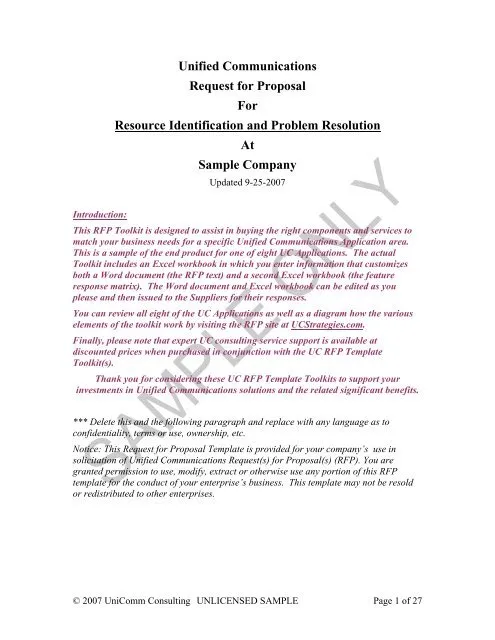Understanding RFP Cover Letters
Responding to a Request for Proposal (RFP) is a critical process for businesses seeking new opportunities. A well-crafted RFP response can be the key to securing a valuable contract. The cover letter is the first impression, setting the tone for the entire proposal. It’s not just a formality, but a strategic tool that can significantly influence the decision-makers. Mastering the art of the RFP cover letter involves understanding its purpose, key components, and how to make it stand out from the competition. This comprehensive guide will delve into the essential aspects of creating compelling RFP response letters, providing actionable insights and examples to help you impress and win.
What is an RFP Cover Letter?
An RFP cover letter is a formal introduction to your company’s response to a Request for Proposal. It accompanies the full proposal document and serves as a concise overview of your capabilities, understanding of the project, and commitment to delivering the requested services or products. Think of it as your opportunity to make a strong first impression, highlighting why your organization is the best fit for the project. It’s a crucial element that sets the stage for the detailed information presented in the full proposal, encapsulating the essence of your offering in a clear, persuasive manner. The cover letter is a reflection of your professionalism, attention to detail, and ability to meet the client’s needs.
Why is an RFP Cover Letter Important?
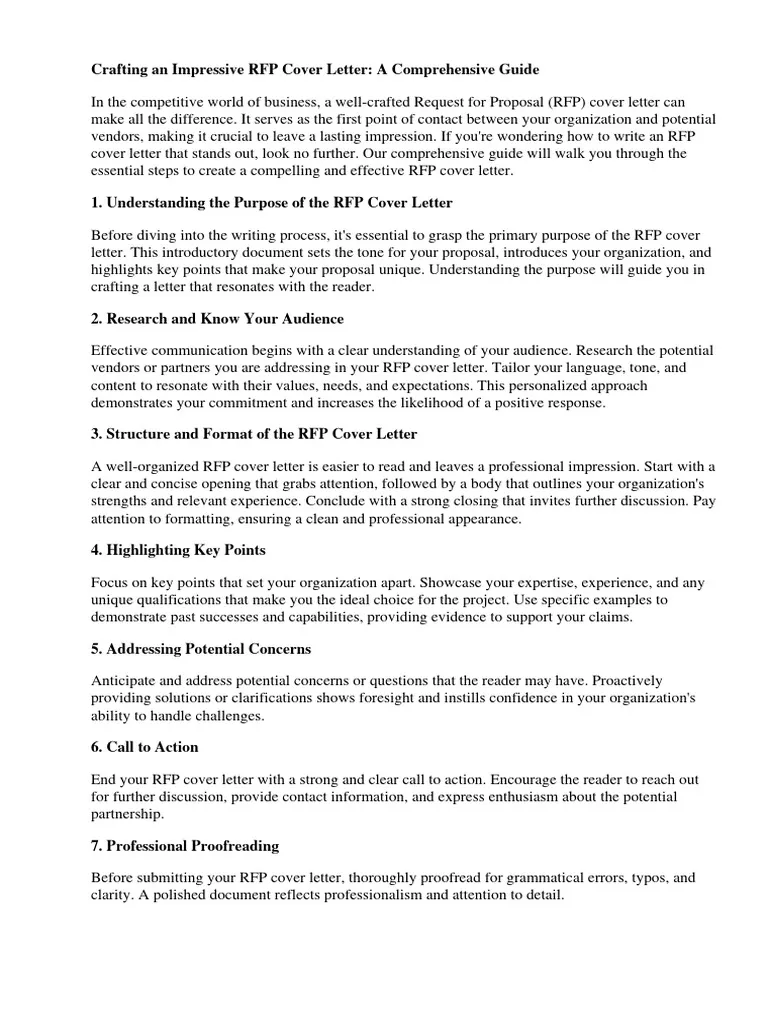
The importance of an RFP cover letter cannot be overstated. It’s the gatekeeper to your entire proposal. Decision-makers often review cover letters first to gauge whether to proceed with a full review of the proposal. A compelling cover letter grabs their attention, demonstrating that you understand the project’s requirements and are enthusiastic about the opportunity. It conveys your company’s unique value proposition, setting the stage for a positive evaluation. Without a strong cover letter, even the most comprehensive proposal may be overlooked. In a competitive landscape, a well-written cover letter can be the deciding factor between success and failure. It is an essential tool to showcase your understanding of the project, establish credibility, and express your commitment to the client’s success.
Key Components of a Winning RFP Response Letter
Crafting a winning RFP cover letter involves incorporating several key components that provide a comprehensive overview of your proposal. These elements work together to present a clear, concise, and compelling case for your company. Each section plays a vital role in conveying your understanding, demonstrating your capabilities, and ultimately, persuading the client to choose your organization.
Executive Summary
The executive summary is a brief, high-level overview of your entire proposal. It should concisely state your understanding of the project, your proposed solution, and the key benefits you offer. This section is crucial for capturing the reader’s attention from the start, providing a snapshot of your proposal’s core elements. Keep it brief and impactful, highlighting the unique value your company brings to the table and why you are the ideal choice for the project. Emphasize the key deliverables, your approach, and the expected outcomes. A well-written executive summary can significantly influence the decision-maker to delve deeper into your proposal.
Company Overview
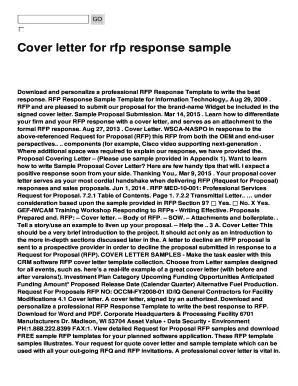
The company overview provides a concise introduction to your organization, highlighting your experience, qualifications, and relevant expertise. Focus on showcasing your company’s strengths and how they align with the project requirements. Briefly mention your mission, values, and any awards or accolades that demonstrate your credibility and success. Tailor this section to the specific RFP, emphasizing experience that is directly relevant to the project. Include key details such as years in business, the size of your company, and the industries you serve. This section builds trust and confidence, illustrating your capabilities to successfully execute the project.
Understanding the Project
Demonstrating a clear understanding of the project requirements is essential for a winning cover letter. Briefly reiterate your understanding of the client’s needs, goals, and challenges as outlined in the RFP. This shows that you have carefully reviewed the document and are prepared to address the specific requirements. Avoid simply restating the RFP; instead, rephrase the requirements in your own words to show your comprehension. Highlight your ability to grasp the project’s objectives and indicate your approach to achieving the desired outcomes. This section demonstrates that you have a strong grasp of the project and a clear plan to meet its needs.
Proposed Solution
The proposed solution section briefly outlines your proposed approach to addressing the project requirements. Summarize your key strategies, methodologies, and any innovative techniques you plan to employ. Highlight the unique features and benefits of your solution, emphasizing how it will meet the client’s specific needs. Clearly state your value proposition and how your solution differentiates you from competitors. This section should provide a compelling overview of your solution while building excitement and anticipation for the details in the full proposal. Focus on the core elements of your approach and how you will ensure successful project delivery.
Pricing and Timeline
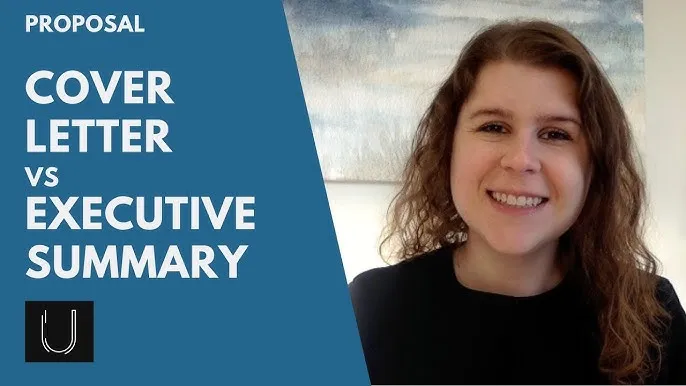
Briefly mention your pricing structure and proposed project timeline. This section provides a high-level overview of the financial and time commitments involved in the project. Avoid including all the detailed pricing information; instead, offer a concise summary, referencing where the complete breakdown can be found in your proposal. Provide a realistic and achievable timeline, showing your commitment to delivering the project on schedule. This demonstrates your ability to manage resources effectively. Ensure your pricing is competitive and transparent. Clearly outline the key milestones and deliverables. This section establishes confidence and helps the client understand the practical aspects of working with your company.
5 Ways to Impress with Your RFP Cover Letter
Creating a compelling RFP cover letter requires more than just summarizing your proposal; it requires strategic finesse to impress the evaluation team. Here are five essential techniques to make your letter stand out and significantly increase your chances of winning the contract.
Highlight Relevant Experience
Focus on your company’s previous successes that are directly related to the project. Instead of broadly listing all your experience, concentrate on projects that demonstrate a clear track record of achieving similar results. Provide specific examples, including the clients you’ve worked with, the scope of the projects, and the positive outcomes you delivered. Quantify your achievements whenever possible, using metrics such as increased efficiency, reduced costs, or improved customer satisfaction. This demonstrates your capability and gives the client confidence in your ability to deliver successful results. Tailor your examples to align with the specific needs and requirements outlined in the RFP.
Focus on Benefits Not Just Features
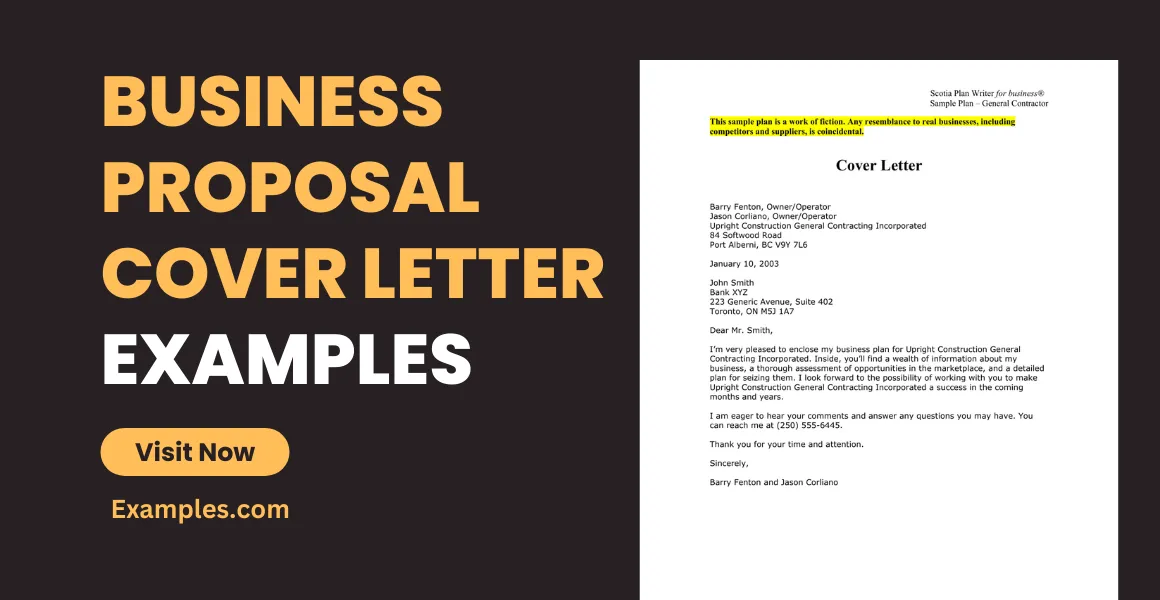
When describing your solution, emphasize the benefits it provides to the client, rather than just listing the features. Explain how your solution will solve the client’s problems, improve their operations, or achieve their goals. Focus on the value you bring to the table. Translate the technical aspects of your solution into tangible advantages, such as increased revenue, reduced risk, or enhanced efficiency. Highlight the positive outcomes the client will experience by choosing your company. For example, instead of stating that your software has certain functionalities, emphasize how those functionalities will streamline the client’s processes and reduce their operational costs. This benefit-driven approach makes your proposal more compelling and persuasive.
Showcase Your Understanding
Demonstrate your deep understanding of the client’s needs, industry, and the specific challenges they face. Go beyond simply restating what’s in the RFP. Conduct thorough research on the client and their industry. Highlight any insights you gained from your research. Show how your solution is specifically tailored to address their unique situation. This level of understanding demonstrates that you’ve invested time and effort in the proposal. It sets you apart from the competition. It also showcases that you are committed to their success. By demonstrating a deep understanding of their specific needs, you build trust and establish yourself as a valuable partner.
Tailor Your Response
Never use a generic, one-size-fits-all cover letter. Customize your response to each specific RFP. Demonstrate your commitment to understanding the client’s unique needs. Tailor your language, tone, and content to align with the specific project requirements. Carefully review the RFP document and address all the key points. Ensure your cover letter reflects the client’s values, culture, and priorities. Customization shows that you’ve taken the time to understand the client’s specific situation. It makes your proposal more relevant and compelling. Generic letters quickly get dismissed. Ensure your letter speaks directly to the client’s needs.
Proofread and Edit Meticulously
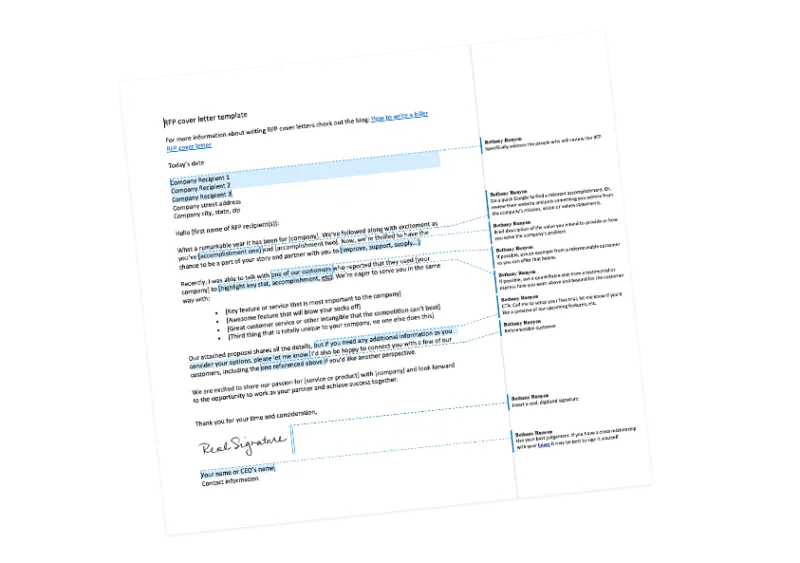
Errors and inconsistencies in an RFP cover letter can damage your credibility and undermine your chances of success. Proofread and edit your cover letter meticulously before submitting it. Check for grammatical errors, spelling mistakes, and inconsistencies in the language and formatting. It is often helpful to have someone else review your letter to catch any errors you may have missed. Ensure that your letter is well-written, clear, and concise. Pay attention to tone and style. Correct any formatting issues to ensure a professional appearance. Attention to detail demonstrates your professionalism. It also reinforces your commitment to quality. A polished cover letter demonstrates that you value precision and are dedicated to providing accurate, high-quality work.
RFP Cover Letter Examples
Reviewing examples of RFP cover letters can offer valuable insights into effective writing techniques. Here are some examples, tailored to different industries, to help you understand how to approach each situation.
Example 1 Technology Solutions
For a technology solutions company, the cover letter should emphasize innovation and problem-solving. It should highlight the company’s ability to provide cutting-edge solutions, solve unique problems, and deliver measurable results. The letter might detail how the company’s proposed technologies and services will improve the client’s efficiency, reduce costs, or enhance their competitive advantage.
Example 2 Marketing Agency
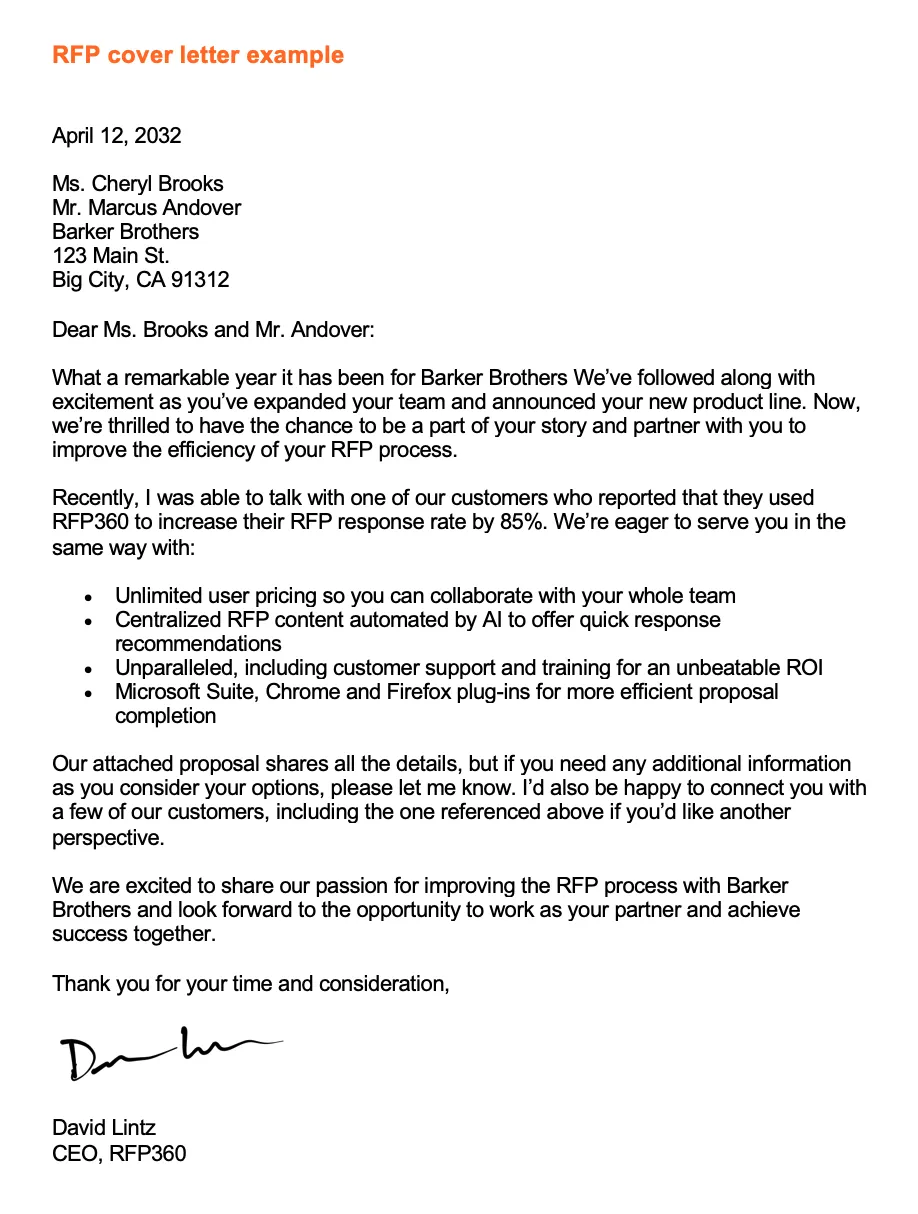
A marketing agency’s cover letter should focus on creativity, strategy, and the ability to drive results. It should showcase the agency’s expertise in crafting compelling campaigns, targeting the right audiences, and measuring the success of their efforts. The letter should highlight the agency’s understanding of the client’s industry, and describe how its proposed marketing plan will increase brand awareness, generate leads, and boost sales.
Example 3 Construction Firm
A construction firm’s cover letter should focus on the company’s experience, expertise, and commitment to quality. It should emphasize the firm’s ability to manage complex projects. It should detail its compliance with industry standards. It should also highlight the firm’s track record of delivering projects on time and within budget. The letter might showcase the firm’s understanding of the project’s specific requirements. It might detail how its proposed construction plan will ensure a safe, sustainable, and high-quality final product.
Conclusion
A well-crafted RFP cover letter is a cornerstone of a successful proposal. By understanding its importance, mastering its key components, and implementing the techniques outlined in this guide, you can significantly improve your chances of winning contracts. Always tailor your response, showcase your expertise, and proofread meticulously. Remember that the cover letter is your first opportunity to impress, so make it count. With careful planning and execution, your RFP cover letters can become a powerful tool for driving business growth and achieving your strategic goals.
